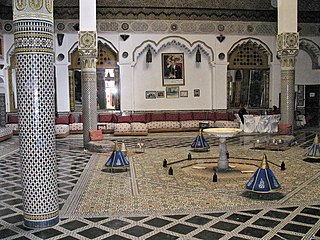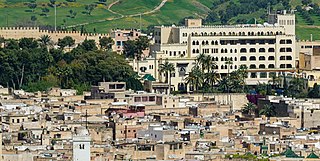
Dar Ba Mohammed Chergui, also known as Dar al-Aman, [1] is a historic palace or riad-style mansion in the old medina of Fez, Morocco. It is located on Derb el Horra street in Fes el-Bali. [2]

Dar Ba Mohammed Chergui, also known as Dar al-Aman, [1] is a historic palace or riad-style mansion in the old medina of Fez, Morocco. It is located on Derb el Horra street in Fes el-Bali. [2]

The house was constructed over 15 years in the early 20th century and is named after the former qa'id (judge) Ba Mohammed Chergui who lived here. [2] [3] In her book on Islamic gardens, D. Fairchild Ruggles also identifies the palace as that of Pasha 'Abd al-Kari and states that it was built instead in 1860. [1]
In 2008 the palace was purchased by international private investors following a long negotiation process with around 60 inheritors of the house. The intention of the purchase was to convert the palace into a five-star hotel. [2] [3] [4] Some observers report that the palace is currently in a dilapidated state and not accessible to visitors. [5] [6]
The palace is among the most impressive historic houses in the city, along with examples like Dar Moqri, Dar Glaoui, and Dar Adiyel. [7] [5] It consists of two main houses next to each other, [5] together covering some 1800 square meters. [2] The main house (dar kbira) consists of a central courtyard paved and decorated with marble and zellij tiling, around which were three ornate halls with cupola ceilings as well as a large and ornate wall fountain. The second house, covering about 650 square meters, [2] includes a large courtyard garden with a unique arrangement of star-shaped and cross-shaped planters and three fountains, all covered with zellij, and a surrounding portico or gallery. [2] [4] [8]

A riad or riyad is a type of traditional Moroccan and Andalusi interior garden or courtyard associated with house and palace architecture. Its origin is generally attributed to Persian gardens that spread during the Islamic period. The term is nowadays often used in Morocco to refer to a hotel or guesthouse-style accommodation with shared common areas and private rooms, often within a restored traditional mansion.

The Bahia Palace is a mid to late 19th-century palace in Marrakesh, Morocco. The palace was first begun by Si Musa, grand vizier of Alaouite sultan Muhammad ibn Abd al-Rahman, in 1859 and then continued and expanded by his son Si Ba Ahmed ibn Musa, grand vizier of Sultan Moulay Abdelaziz between 1894 and 1900. Today it is a well-known historic monument and tourist attraction in the city.

The Museum of Marrakech is a historic palace and museum located in the old center of Marrakesh, Morocco. In addition to its notable architecture, the museum's collection showcases various historic art objects and contemporary art from Morocco.

The Mosque of the Andalusians or Al-Andalusiyyin Mosque, sometimes also called the Andalusian Mosque, is a major historic mosque in Fes el Bali, the old medina quarter of Fez, Morocco. The mosque was founded in 859–860, making it one of the oldest mosques in Morocco. It is located at the heart of a district which was historically associated with Andalusi immigrants, from which it takes its name. It has been renovated and expanded several times since then. Today, it is one of the relatively few remaining Idrisid-era establishments and one of the main landmarks of the city.

Dar Batḥa, or Qasr al-Batḥa, is a former royal palace in the city of Fez, Morocco. The palace was commissioned by the Alaouite Sultan Hassan I in the late 19th century and finished under his successor Abdelaziz. It was converted into a museum of historical arts and crafts in 1915 with a collection that now comprises over 6,500 objects. The palace is located near Bab Bou Jeloud at the western edge of Fes el-Bali, the old medina quarter of the city, and close to Fes el-Jdid, the new medina quarter. It is adjacent to the Dar el-Beida palace located to its southeast, which was originally part of the same complex.

The Royal Palace or Dar al-Makhzen is the palace of the King of Morocco in the city of Fez, Morocco. Its original foundation dates back to the foundation of Fes el-Jdid, the royal citadel of the Marinid dynasty, in 1276 CE. Most of the palace today dates from the 'Alawi era. The vast grounds are home to multiple private structures, patios, and gardens, but historically also included administrative offices and government tribunals. Today, the most publicly visible parts of the palace are its main entrances at the Old Mechouar and the highly ornate 20th-century gates at Place des Alaouites, near the Mellah.

The architecture of Fez, Morocco, reflects the wider trends of Moroccan architecture dating from the city's foundation in the late 8th century and up to modern times. The old city (medina) of Fes, consisting of Fes el-Bali and Fes el-Jdid, is notable for being an exceptionally well-preserved medieval North African city and is classified as a UNESCO World Heritage Site. A large number of historic monuments from different periods still exist in it today, including mosques, madrasas, synagogues, hammams (bathhouses), souqs (markets), funduqs (caravanserais), defensive walls, city gates, historic houses, and palaces.

Dar el Bacha is a palace located in the old medina of Marrakesh, Morocco. It currently houses the Museum of Confluences.

The Jnan Sbil Gardens, also known as the Bou Jeloud Gardens, is public garden in Fez, Morocco, located between Fes el-Jdid and Fes el-Bali, the two sections of the old medina.

The Mnebhi Palace or Menebhi Palace, also known by its French name Palais Mnebhi, is a historic early 20th-century palace in Fes el-Bali, the old medina of Fes, Morocco. It is notable for both its lavish architecture as well as for being the place where the 1912 Treaty of Fes was officially signed. It is located on Tala'a Seghira street, one of the main souq streets of the city.

Dar Adiyel or Dar 'Adiyil is a historic mansion in Fes el-Bali, the old medina of Fes, Morocco. It is located in the Zqaq el-Bghal neighbourhood, a short distance south from Tala'a Seghira street.

Dar Moqri is a historic palace or group of mansions in Fes el-Bali, the old medina of Fes, Morocco. It dates from the late 19th and early 20th centuries and was built by the wealthy and powerful Moqri family. The site is occupied by two grand residences built separately by members of the same family but physically adjoining each other. The older palace was begun by Abdelsalam al-Moqri and probably further modified by his son Muhammad. In addition to its rich interior, it is notable for its large terraced garden. The second palace belonged to his grandson Si Tayb and is notable for its long courtyard which mixes Italianate details with traditional Moroccan decoration. A completely separate palace, known as Riad Driss Moqri, was also built further north by Abdelsalam's son, Si Dris.

The Jamai Palace, also known as the Dar Jama'i or the Palais Jamaï, is a historic late 19th-century mansion near Bab Guissa in Fes el-Bali in Fes, Morocco. It was converted to a luxury hotel in 1919, which closed in 2014.

The Kasbah of Moulay Ismail is a vast palace complex and royal kasbah (citadel) built by the Moroccan sultan Moulay Isma'il ibn Sharif in Meknes, Morocco. It is also known, among other names, as the Imperial City or Palaceof Moulay Ismail, or the Kasbah of Meknes. It was built by Moulay Isma'il over the many decades of his reign between 1672 and 1727, when he made Meknes the capital of Morocco, and received occasional additions under later sultans.

The Dar Jamai Museum is a museum in Meknes, Morocco. It displays a number of artifacts and art objects from the city and other regions in Morocco. It is housed in a late 19th-century palace built by the Jama'i family who also built the Jamai Palace in Fes.

Dar Moulay Ali is a historic residence and riad in Marrakesh, Morocco. It is located right next to the Kutubiyya Mosque. It currently houses the French consulate.

Dar Glaoui or Glaoui Palace is a late 19th-century and early 20th-century palace in Fez, Morocco. It was owned by the Glaoui family, whose most famous members were the Grand Vizier Madani and his brother Thami, pasha of Marrakech. The palace is located in the southwestern district of Fes el-Bali, in an area containing other historic mansions.

The Collège Moulay Idriss, known today as the Lycée Moulay Idriss, is a historic secondary school in Fez, Morocco.

The Dar el-Beida is a royal residence in Fez, Morocco. It was originally part of the same complex as the adjacent Dar Batha to its northeast, but was separated in 1915 as the latter was repurposed as a museum. It remains an official residence today, inaccessible to the public.

Traditional houses in Morocco are usually centered around a large internal courtyard, the wast ad-dar, and are characterized by a focus on interior decoration rather than on external appearance. The houses of wealthy residents featured decoration typical of Moroccan architecture and medieval Moorish architecture, including carved and painted wood, carved stucco, and zellij. The center of larger houses could also be occupied by a riad, particularly in places like Marrakesh where more space was available.